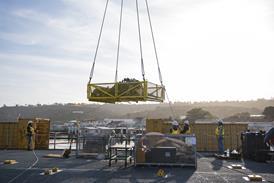
Guy Norris/LOS ANGELES
Alan Mulally, the newly appointed president of Boeing Commercial Airplanes, walks eagerly to the corner of his office and turns on the computer. Like an instant "state of the nation" monitor, the screen summarises the status of every single Boeing Commercial aircraft coming off the production lines and charts their progress from test flight to customer acceptance.
To Mulally, this screen is much more than a handy book-keeping tool. Like a thermometer, it is a real time indicator of the health of Boeing itself, and his watchful eyes like what they see. "Boeing is coming back," he predicts as he tots up the deliveries towards the formidable 1998 year-end target of 550 aircraft. With just over a month to go before this decidedly forgettable year is over, the question is: will Boeing's health continue recovering quickly enough to meet the challenge?
According to Mulally, the answer is an optimistic "yes". He adds: "The data sets you free - it always has done - and when you look at the quality of the aircraft and the delivery performance, the shortages coming down and getting work back in sequence, it starts getting better. In every category, we've improved by between 40% and 50%, and some are 60% better than this time last year."
The big problems include parts shortages, behind-schedule jobs and out of sequence work. This last snag was particularly damaging to the company on the Next Generation 737 line, which caused most of the problems from mid-1997 onwards. "Some people think it is between five and 15 times the cost when it's out of sequence," according to Mulally.
Jobs behind schedule had reached epidemic proportions on the line which, at the delivery rate of 14 aircraft a month, peaked at more than 16,000 at one stage. With the company committed to increasing the delivery rate to 21 aircraft a month, and possibly more, something had to be done.
The growing financial burden of the difficulties had already forced Boeing to double the Next Generation break-even to about 800 aircraft, and losses jumped dramatically because of these and other production and delivery problems.
Now, as Boeing Commercial nears the end of its third month under Mulally's stewardship, there seem to be signs of change. The Next Generation line, for example, moved up to 21 aircraft a month in October without disruption and the company is gearing up to raise this figure to 24 a month next February.
The increased rate has already seen jobs behind schedule drop to 2,600, and even the morale of the workers is said to be higher - which Mulally appreciates. "Morale has been down. They've worked so hard and yet they did not get us over-committed. They are doing a fabulous job in trying to get us to recover."
Mulally spreads out a chart of the new organisation like a general preparing his battle plan. First, he explains a few basic ground rules. This is not "Mulally's plan", he says, it is a "better plan" created by Boeing "to improve the way we manage the business". Second, the emphasis is on looking forward, not back. "We're going to improve the business, which means obviously we didn't think the previous system was working."
The key to the whole plan is simplicity and a focus on customers. This is reflected throughout, from the chain of command all the way to the new layout of the entire Boeing Commercial Airplanes company. It has been reorganised into well-defined business units - single-aisle, twin-aisle and customer service. All are supported by the groups overseeing the aircraft components that the company makes and buys, and are allied to a set of "process councils and skill teams" with expertise in areas such as operations, engineering, quality and finance.
"Each business unit will pull together all revenue and cost, which will enable us in our extended enterprise to work together on one integrated plan to continuously improve quality and production-process efficiency," says Mulally. "We are pulling together around one plan with clear performance measures."
Inspiration for the new structure came from two fundamental sources: talking to customers and following a pattern similar to that formed during the absorption of Rockwell North American and McDonnell Douglas.
"What is that neat expression where structure follows strategy?" says Mulally. "I talked to customers, I talked to the employees, I talked to as many people as I could when I was asked to come back over and serve in Commercial Airplanes. Everybody said it would be really valuable to organise all of Boeing - the whole extended enterprise - around being focused on the customer. That's why we are lining up the entire Boeing production system underneath the customer."

Mulally's personal conviction of the benefits of being "customer driven" and "working together" is stamped firmly on the new chart. "The customers are buying products and services. They don't buy wings, they buy aircraft. That's why all the components are being lined up to support the aircraft programmes and the support of the aircraft in service.
"In the past, all these components were reported separately from the aircraft. But I've never seen a wing go down the runway and take off by itself. Not everybody gets this, but it is a big deal. It is like the Toyota production system. This is simply lining up everything and focusing on the aircraft.
"What I want to do is bring an intensity of focus, to really work on what the customers value. Our first priority is to deliver and support quality aircraft. So I think that what this is going to feel like to the customers is that the whole Boeing company is lined up to support you.
"When you think about that, it is absolutely critical to the airlines just as much as new aircraft. So what we wanted to do was manage the new business absolutely aligned with the airlines."
The new structure is essentially "flatter", with five people, including the president, at its head. "Now everybody is involved," says Mulally. "This is my team. We meet together every week and we run through the whole business plan and it is all led by these people. This question was the biggest thing on my agenda. How do you get everybody on the same plan? You don't do it by passing it down through an organisation. You completely flatten the whole organisation so that everyone can get involved."
Single-aisle products such as the 717, 737, 757 and, briefly, until their closure in 2000, the MD-80, MD-90 and widebody MD-11, are now managed by Jim Jamieson. The twin-aisle 747, 767 and 777 are being managed out of Everett by Jim Morris, while Tom Schick assumes control over customer services. Fred Mitchell manages the Airplane Components unit and the respective parts feeding it. These include wings, propulsion, interiors/systems and material as well as the individual Boeing manufacturing sites at Auburn, Tulsa and Wichita.
Reporting independently to Mulally are the process councils and skill teams. As an example, Walt Gillette is the "functional skill team leader" for engineering. "We call them process councils, and anything associated with what engineering has done throughout the whole place," says Mulally. "This includes everything from CATIA [the Dassault/IBM design tool] to flight test. Walt is working on common engineering processes throughout this organisation. So all these people, all these team leaders, are like extensions of me."
Other councils and teams include operations, quality, sales, business development and communications, administration, legal, contracts and ethics, people and finance.
With the focus fixed on meeting the formidable delivery target for 1998, the full impact of the structural changes on future product development strategy, international partnerships and asset use has yet to be felt.
With Boeing's confidence in a full recovery growing daily, however, there are signs that Mulally's team is preparing for an equally aggressive shake-up of other plans for 1999 and beyond. In the meantime, all eyes are firmly on that 550 delivery target.
MULLALLY'S TOP FIVE TARGETS
Delivering and supporting on schedule.
Top priority is being given in the "better plan" to deliver and support "quality aircraft on schedule again", says Mulally.
Healthier production system.
Reduce parts shortages, get out-of-sequence work back in sequence at every step in the production process, from the suppliers to final assembly and delivery.
Process improvement.
Remove non value-added activities, change, error and rework to streamline production process, reduce cycle time and inventory. Lean manufacturing, DCAC/ MRM and working with suppliers will be used to simplify the production process and reduce the cost of production.
Product development.
Introducing a lot of aircraft-product definition change and variability into the production system.
Working together.
Establishing a tighter "working together" practice through the new organisational structure and formation of the business unit. The reorganisation "fundamentally changes the way we manage our business", says Mulally.
Source: Flight International























